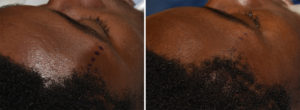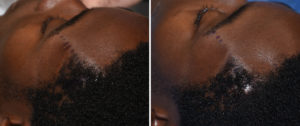Temporal muscle removal has been shown to be effective at head width reduction. By removing the posterior temporal muscle belly, which is much smaller than the larger anterior temporal muscle and sits above the ears, a round or convex head shape can be narrowed. Interestingly the removal of this portion of the temporal muscle has no adverse effects on jaw function.
But for those who have a wide head width, the anterior temporal muscle may also be too thick. This creates a temporal convexity by the side of the eye in which a slight temporal hollowing is often aesthetically preferred. Such anterior temporal convexities seem to be an exclusive male aesthetic trait that is often seen in certain ethnicities. (e.g., Asians, Blacks)
The treatment of a large anterior temporal muscle is with Botox injections rather than surgery. Debulking the anterior temporal muscle is much more potentially problematic than that of the posterior temporal muscle. It is a hard area to access without more prominent incisions and the thickness of the muscle makes thinning it difficult.
One approach to anterior temporal reduction is that of a temporal lipectomy. There is an extension of the buccal fat pad that does reach up into the anterior temporal region. But it is often not that large and usually only affects the lower temporal region.

This high frontal approach to anterior temporal reduction is most appropriate for those patients who are bothered by fullness to the side of the forehead. It will not reduce temporal fullness down by the zygomatic arch where eyeglasses would traverse.
Dr. Barry Eppley
Indianapolis, Indiana



